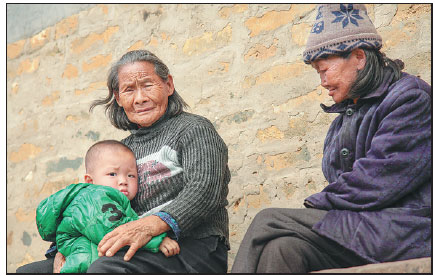County eyes prosperity through tourism
China Daily, June 17, 2016 Adjust font size:

Villagers sit in the sun at Yangjiao Water Castle in the old town of Junmenling.
A chance to experience life in a military castle built nearly 550 years ago, an excursion to rugged mountain vistas high up in the pristine air and a glimpse of a vibrant county striving to break free of poverty.
This is what Huichang, in Jiangxi province, promises visitors - a haven for curious tourists who are tired of the crowds.
It is said that the county got its name in AD 982 during the Northern Song Dynasty (960-1127), when an ancient brick bearing the characters for hui chang, which literally means "will prosper", was unearthed while digging a well.
More than a thousand years later, Huichang has seen some prosperity - the income of farmers in the area posted a 14 percent rise last year, and most residents now own at least one mobile phone. But the county, which at 2,700 square kms is roughly the same size as urban Miami in Florida, seems not to have fully lived up to the expectations of those who named it.
For one, it has yet to lift 47,000 people, or about one-tenth of its population, out of poverty. These people, many of whom are illiterate, live on an annual income of less than 2,300 yuan ($365) - the poverty line below which 70 million Chinese still live.
However, under the national poverty-relief program, Huichang is entitled to a slew of preferential policies and financial support for its development projects, which are designed to help lift all of its poor out of poverty by 2020.
The county sits at the confluence of two waterways that go on to form the Gan River, a principal southern tributary of the Yangtze River and the lifeline of Jiangxi province.
In ancient times, people from northern China used these rivers to travel or migrate as far as Junmenling in southern Huichang county, a mountainous town that serves as a gateway to the neighboring Fujian and Guangdong provinces in South China.
At least 95 percent of Huichang's population come from the Hakka ethnic group - one of the highest concentrations in the country.
Hakka is the Cantonese pronunciation of the Mandarin word kejia, which literally means "guest people" - fittingly, a census conducted in 1990 found that the occupants of Junmengling were descendants of settlers from at least 11 provinces throughout China.
Legend has it that a foreign letter sent to the town during the War of Resistance against Japanese Aggression (1937-45) needed only to be addressed to "China Junmenling" because it was so well known for its salt and rice ventures with overseas business links.
Today, Junmenling is better known among tourists for its historic castle and the scenic Hanxianyan area.
Construction of Yangjiao Water Castle, at the headwaters of the Gong River, began in 1465 and work on a 10-meter-high wall encircling the castle started in 1543. Upon its completion, nearly 1,000 farming households were relocated to live within the walls, ready to defend the castle during times of unrest.
It is said that all the dwellers in the castle had the same family name - Zhou, and there are still people living in it today.
Zeng Lingzhen, director of the Huichang Tourism Bureau, said the government had spent millions of yuan to repair and restore parts of the castle, so that more travelers can experience life within its walls.
A short walk away is the Hanxianyan scenic area, where wooded mountains act as a kind of open-air museum for ancient carvings and calligraphic inscriptions, made on the cliffs by monks, officials and men of letters from days long past.